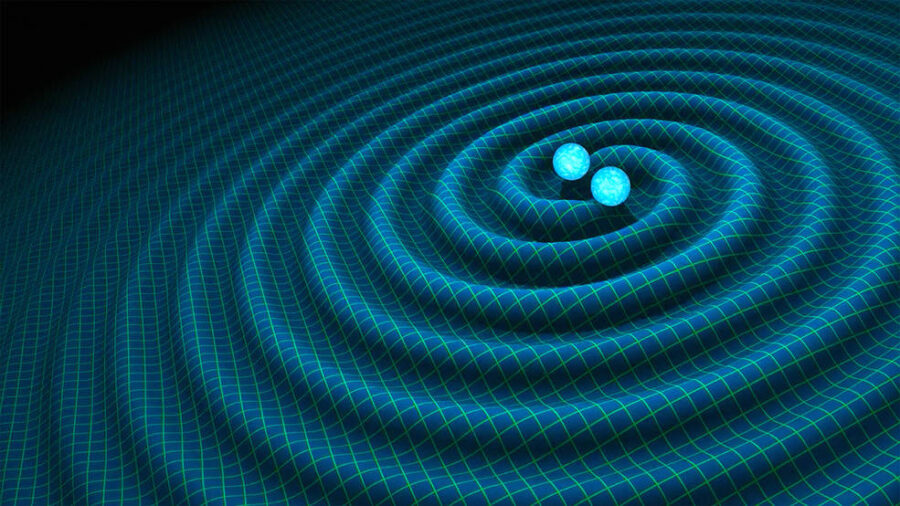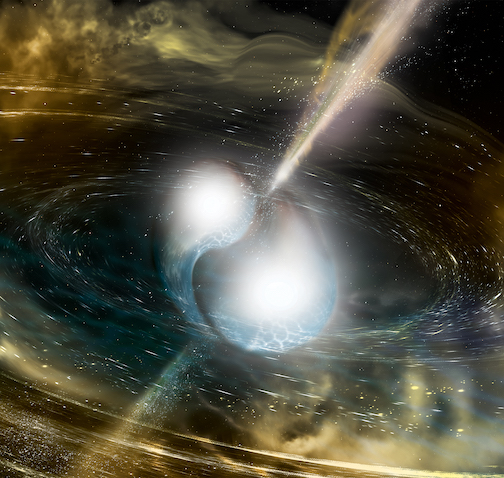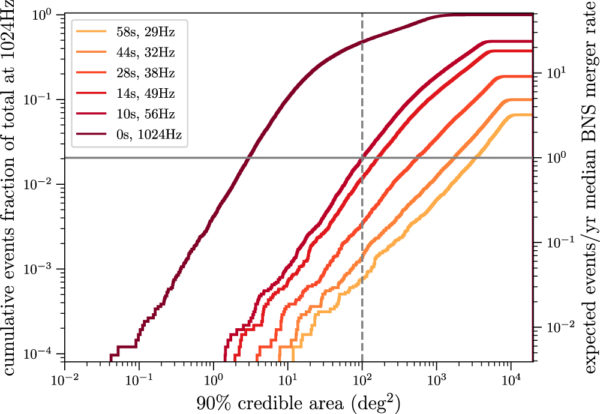What if gravitational-wave observatories could send out alerts right after — or even before — receiving signals of neutron star collisions?

R. Hurt / Caltech-JPL
On 17 August 2017, an alert went out roughly 40 minutes after the LIGO observatory detected gravitational waves from a pair of colliding neutron stars. This alert sent telescopes worldwide slewing rapidly in an all-hands-on-deck effort to image the fireworks show accompanying the merger.
But what if that alert had gone out before the collision?
When Stars Collide
When neutron stars merge, they are expected to produce both a gravitational-wave signal from their inspiral and a host of spectrum-spanning electromagnetic signatures from before, during, and after the collision.
The event captured in August 2017, known as GW170817, is one of just two binary neutron star mergers we’ve observed with LIGO and its European sister observatory Virgo so far. But these collisions are likely to become a common detection in the future, particularly as LIGO and Virgo continue to upgrade and approach their design sensitivity.

NSF / LIGO / Sonoma State University / A. Simonnet
Reducing the Lag
In the case of GW170817, interferometer glitches and data transfer issues prevented an alert from going out until 40 minutes after the merger. By the time follow-up telescopes had been advised where to search for the collision, the relevant region of the sky was below the horizon; the first manual follow-up couldn’t be conducted until nearly 8 hours after the merger.
To capture a neutron star merger without this delay, we’ll clearly need reduce the alert lag time — but could LIGO send out alerts even before the neutron stars collide? A study led by Surabhi Sachdev (The Pennsylvania State University) has recently demonstrated that a LIGO data analysis pipeline will be capable of providing advance warning for some future mergers.
Early Warning
Sachdev and collaborators analyze the performance of GstLAL, an early warning gravitational-wave detection pipeline for LIGO/Virgo that looks for signals of neutron star binaries approaching merger.

Sachdev et al. 2020
By injecting merger signals into a simulated dataset, the authors show that the pipeline is able to recover many of these signals 10–60 seconds before the merger occurs. These early detections are made possible when mergers happen nearby, so that a large signal-to-noise ratio can accumulate as the neutron stars inspiral in their last few moments collision.
A Well-Notified Future
Sachdev and collaborators predict that when LIGO and Virgo reach their design sensitivity, nearly 50% of total detectable mergers will be spotted at least 10 seconds before merger — a total that amounts to perhaps 6 to 60 events per year, depending on the neutron star merger rate.
With rapid localization and quick relay times for alerts, this early-warning system could provide follow-up telescopes with the opportunity to capture neutron-star mergers in real time, as they happen. Such observations would provide insight into what magnetic conditions are like around the neutron stars, how heavy elements are synthesized, and whether binary neutron stars are the source of fast radio bursts.
Citation
“An Early-warning System for Electromagnetic Follow-up of Gravitational-wave Events,” Surabhi Sachdev et al 2020 ApJL 905 L25. doi:10.3847/2041-8213/abc753
This post originally appeared on AAS Nova, which features research highlights from the journals of the American Astronomical Society.
 4
4









Comments
jackkessler
January 8, 2021 at 4:35 pm
In the artist's impression the neutron stars are shown as glowing. Do neutron stars have accretion disks like black holes do? Or do they glow just because they are hot? Or for some other reason?
You must be logged in to post a comment.
Monica Young
January 8, 2021 at 7:21 pm
That's a good question — in this case, they wouldn't have accretion disks, the stars themselves would be glowing. Their surfaces are extremely hot, several hundred thousand degrees.
You must be logged in to post a comment.
MikeyKokomo
January 10, 2021 at 4:05 pm
This is above my pay grade. I expect accretion disks are likely until the shockwave created at the merger, clears that loose material and gas from the area. As with blockholes, the friction within the accretion disk creates extreme heat and thus glows. It is my understanding that an electron dropping from a high energy state to a lower energy state is what emits the photon. I expect the neutron stars themselves, having expelled all previous protons and electrons could not generate photons, except at their surface.
You must be logged in to post a comment.
Andrew James
January 10, 2021 at 5:08 pm
Part of the glow is caused by gravitational redshifts (relativity effect), as the light is greatly distorted near to strong gravity sources. The behaviour of the degenerate gas is 'Buchdahl bound' (Buchdahl's theorem), where the gas density decreases by radius in an unusual way above the neutron star. It behaviour is further influenced by the intense magnetic fields, This is made more complicated by having two close neutron stars, where the observed effects would become warped.and twisted. As the two stars inspiral this is further magnified. [Math for this is just awful.]
I'm unsure if the artist's impression is 100% accurate because understanding such complex interactions is still in its infancy. Even if were possible to witness this in person, you'd be instantly fried by the radiation! At least it give a sense of such an extreme environment.
You must be logged in to post a comment.
You must be logged in to post a comment.